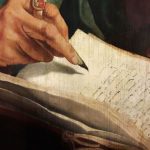 Technology
Technology  Technology
Technology  Humans
Humans 10 Everyday Human Behaviors That Are Actually Survival Instincts
 Animals
Animals 10 Animals That Humiliated and Harmed Historical Leaders
 History
History 10 Most Influential Protests in Modern History
 Creepy
Creepy 10 More Representations of Death from Myth, Legend, and Folktale
 Technology
Technology 10 Scientific Breakthroughs of 2025 That’ll Change Everything
 Our World
Our World 10 Ways Icelandic Culture Makes Other Countries Look Boring
 Misconceptions
Misconceptions 10 Common Misconceptions About the Victorian Era
 Mysteries
Mysteries 10 Strange Unexplained Mysteries of 2025
 Miscellaneous
Miscellaneous 10 of History’s Most Bell-Ringing Finishing Moves
 Technology
Technology Top 10 Everyday Tech Buzzwords That Hide a Darker Past
 Humans
Humans 10 Everyday Human Behaviors That Are Actually Survival Instincts
 Animals
Animals 10 Animals That Humiliated and Harmed Historical Leaders
Who's Behind Listverse?

Jamie Frater
Head Editor
Jamie founded Listverse due to an insatiable desire to share fascinating, obscure, and bizarre facts. He has been a guest speaker on numerous national radio and television stations and is a five time published author.
More About Us History
History 10 Most Influential Protests in Modern History
 Creepy
Creepy 10 More Representations of Death from Myth, Legend, and Folktale
 Technology
Technology 10 Scientific Breakthroughs of 2025 That’ll Change Everything
 Our World
Our World 10 Ways Icelandic Culture Makes Other Countries Look Boring
 Misconceptions
Misconceptions 10 Common Misconceptions About the Victorian Era
 Mysteries
Mysteries 10 Strange Unexplained Mysteries of 2025
 Miscellaneous
Miscellaneous 10 of History’s Most Bell-Ringing Finishing Moves
10 Female Adventurers That Changed the World
Somehow, history seems to glaze over some of the most important female adventurers of all time. While we often hear about Amelia Earhardt, many other amazing women have become mere footnotes found in dusty old history books or lost in the hidden corners of the internet. Luckily for you, this list covers ten of these enigmatic trailblazers that time often forgets.
Related: Top 10 Recent Discoveries Involving Famous Explorers
10 Aimée Crocker
To kick off the list is one of history’s most badass female explorers: Aimée Crocker. Crocker was born in 1864 and was known for her collection of husbands, lovers, adopted children, Buddhas, pearl tattoos, and snakes. She survived headhunters in Borneo, a poisoning in Hong Kong, a murder attempt by knife-throwing servants in Shanghai, and lived for a whole ten years in “the Orient.”
At age ten, she inherited millions when her father died, but she wouldn’t enjoy the wealth until much later. As a boy-crazy teen, her mother sent her to boarding school in Germany, but that didn’t stop the young girl. After a brief engagement with a prince and an affair with a Spanish bullfighter, Crocker seemed to find someone to commit to—at least for a while. In 1883, Crocker married her first of at least five recorded husbands, Porter Ashe. After the birth of their daughter, the marriage ended, and Ashe was awarded custody of Alma. During her travels throughout the Far East in 1888, Crocker eventually married Commodore Henry Mansfield Gilling—who Crocker met during her explorations. Though married, Crocker did not cease having affairs, usually with powerful men.
Crocker’s third marriage lasted much longer. She met Jackson Gourard at a Buddhist colony that she had organized in New York. Their relationship lasted until his death in 1910, with the couple adopting three children. The couple led a lavish and lascivious lifestyle—at least to the upper-crust conservative members of society—throwing parties and events that shocked some and entertained many. This included an event, “The Dance of All Nations,” that featured controversial and forbidden performances. One, in particular, caused quite a stir: The “cannibal” dancer Dogmeena, wearing a costume consisting of coconut oil and a red sash, enthusiastically danced in La Danse des Igorrotes. Her final two (confirmed marriages) were both to Russian princes much younger than herself (one being 26 to her 62!).
Crocker published several memoirs on her journeys, and her talent for writing is no surprise when you consider her friendship with the one, the only, Oscar Wilde. One of the coolest facts about Crocker, however, has to be that King Kalakaua of Hawaii was so enchanted with her that he gave her a whole island and the title Princess Palal-Kalani (“bliss of heaven”). Such a cool gal.[1]
9 Ida Pfeiffer
Ida Pfeiffer went against the norms and conventions expected of a typical Georgian-era lady, merely out of spite. Born in Vienna in 1797, she took her first trip at age five (not alone, obviously). But it gave her a taste of what the world had to offer. She married a widower to escape home and subsequently became the breadwinner before beginning her explorations. She started traveling around the age of 45 and made two world tours. Her first trip lasted three years. She traveled the Asian continent extensively and went through the Holy Land, Egypt, and Italy, after being told numerous times that, as a female, she simply would not be able to do it.
Recognized as the first European woman to make a tour around the world, Pfeiffer inspired many women of the time to take trips. She was, without doubt, the first European tourist to travel alone, with the aim of relaxing and learning. She lived with tribes in Borneo and Brazil, and as she became an icon for women of the era, steamships and railways offered her free travel. Truly, she was the first person to truly finesse the system. The Austrian government granted her 150 florins to continue with her travels, and oh man, she thrived. After surviving headhunters and cannibals, Pfeiffer contracted a tropical fever, which resulted in her death in 1858.[2]
8 Nellie Bly
The reporter known as Nellie Bly was born Elizabeth Jane Cochran in Cochran’s Mills, Pennsylvania, in 1864, where her father was a mill owner and county judge. Her mother was from a wealthy Pittsburgh family. Young Nellie was the youngest of 13, and when her father died when she was six, she learned some hard lessons about life. After reading an article about what girls were good for—which dismissed the qualifications of female workers. With a passion for writing, she replied to the article and was actually offered a job by the paper’s editor.
And that began Bly’s career as an investigative journalist. Several movies feature Bly and her creative genius, such as Escaping the Madhouse. If you can’t tell from this title, one of Nellie’s most popular writings focuses on when she pretended to be ill to sneak into an asylum. Her ultimate goal was to document the horrors that went on inside and ultimately expose the people who ran it. This story was followed by investigations and exposés on sweatshops, baby buying, jails, and corruption in the legislature.
However, her most famous adventure involved travel—world travel, to be exact. While working for The World newspaper, she decided to take Jules Verne’s famed book Around the World in 80 Days on as a challenge. Departing New York on November 14, 1889, with only two dresses and one suitcase, Bly traveled by many means, including boat, train, horse, and rickshaw. She returned to New York in 72 days, 6 hours, 11 minutes, and 14 seconds—definitely beating Verne’s fictional timeline. Legend.[3]
7 Annie Londonderry
Annie Londonderry was the pioneer of obtaining sponsorship through manipulating the media and using corporations to her advantage. She traveled the world, largely by bike, to win a bet and prove that it could be done by a woman. Also known as Annie Cohen Kopchovsky, Londonderry was a Latvian immigrant who became the first woman to bicycle around the world.
In 1894, two Boston businessmen wagered that Londonderry couldn’t make the perilous journey with the allotted timeframe (15 months) to win a $10,000 prize. Oh, and she had to earn $5,000 while she traveled as well. First heading to New York, Londonderry took a ship to France to continue her journey. Between traveling by ship across water and her bike by land, she fulfilled the terms of the wager. She sold photographs of herself, made public appearances in stores, and became a mobile billboard.
One newspaper described this adventure as “the most extraordinary journey ever undertaken by a woman.”[4]
6 Dian Fossey
Dian Fossey is a female adventurer that you might likely know a little about. She was a primatologist and conservationist. Basically, after working as a ranch hand for several years, she decided to head off to Africa to study gorillas.
Fossey spent 18 years on and off among the mountain gorillas of Rwanda. She was to them what Jane Goodall is to the chimpanzees of Tanzania: she devoted her life to them and made us aware of their existence. She began her work along the Zaire and Uganda borders in 1967, setting up her camp high in the Virunga Mountains. This was the location of the world’s largest population of Gorilla gorilla beringei—around 240 individuals, in some twenty groups, each led by a dominant silverback male.
After years of observing and slowly allowing the gorillas to get accustomed to her, Fossey was finally able to sit with them while they ate and played. She studied the four groups, learning to identify them individually and by family relationship after 11,000 hours in the field. She observed little-known behaviors, including infanticide and the migration of females among groups, enabling the world the learn more about these creatures. Her research formed the basis for the book Gorillas in the Mist, which was turned into a movie. Several articles she wrote and a documentary also brought her research to life for many people.
Unfortunately, Fossey was murdered in 1985. Her skull had been cracked with a machete blow, and the cabin that she stayed in was filled with overturned furniture and broken glass. Nobody knows who killed her, and the mystery is still unsolved today.[5]
5 Gertrude Bell
Described as the “most powerful woman in the British Empire,” GertrudeBell is considered to be even more influential than the Welsh explorer T. E. Lawrence. Bell helped form the modern state of Iraq and was an archaeologist, spy, and diplomat in the Middle East.
Bell was born in Durham County, England, in 1868 to wealthy parents. Her mother died when she was only three, developing a close relationship with her father. Extensively educated, Bell was known to have political conversations with her father and even help several government positions. Bell mounted lavish desert expeditions in the years leading up to World War I, managing to penetrate local tribes using her natural ease and charm, cultural awareness, and a command of the language, as many of her male contemporaries could not. The British government eventually recruited her to work as a spy. She was so in tune with and connected to the region that she became a power player in post-war negotiations to shape the Middle East, particularly in redrawing the southern border of Iraq.
Lawrence of Arabia is said to have been intimidated by meeting a woman who was “his intellectual equal” and who “spoke better Arabic than him.” She served as a mediator between the Arab government in Iraq and the British officials. She explored, mapped, and became highly influential in British imperial policy-making due to her knowledge and contacts. She traveled extensively through Greater Syria, Mesopotamia, Asia Minor, and Arabia and helped to support the Hashemite dynasties in what is today Jordan. Bell wrote several books during her travels and also left behind 7,000 negatives of photographs from her journeys, which are now kept with her papers at the Gertrude Bell Archive at Newcastle University.[6]
4 Harriet Chalmers Adams
In all of the photos of Harriet Chalmers Adams, she even dresses like a classic explorer should, with the hard hat and the khaki-colored jackets. She was born in 1875 in Stockton, California, and went on her first expedition two years later, accompanying her father to the Sierra Nevada mountain range. At the age of eight, she explored the Pacific coast on horseback, all the way from California to the Canadian Rockies. At 14, she accompanied her father on a year-long journey from Oregon to Mexico. She would later say about her adventures, “I’ve never faced a difficulty a woman could not handle as well as a man.”
In 1903, she and her husband, Franklin Adams, began a three-year, 40,000-mile trek through many remote and unmapped regions of South America. During her adventures, she traveled by horseback and in dugout canoes. Amazingly, she survived a myriad of hardships. These included an earthquake in Bolivia. During a particularly harsh blizzard, while climbing in the Andes, they curled up with their guides’ llamas, staying warm and surviving until the morning. Adams also survived close encounters with vampire bats, boa constrictors, and alligators; and was the first woman to travel from the Amazon river to Cayenne. Neither illness nor injury seemed to stop Adams, who didn’t stop traveling even with a severe back injury. The couple also followed the trails of Christopher Columbus and traveled from Siberia to Sumatra.
Adams wrote articles on her adventures for National Geographic and mastered Spanish, Portuguese, Italian, German, and French. She became a war correspondent and was the only female journalist permitted to visit soldiers at the front lines and take photographs of French battles.[7]
3 Dervla Murphy
Dervla Murphy is known for cycling around the world, taking very little with her. The main thing she carried was a .25 automatic pistol, which was then used in self-defense against attackers and wolves.
There are several books out about Murphy which focus on her overland cycle trips through Europe, Iran, Afghanistan, Pakistan, and India. Along the way, she met endless incredible people, such as Tibetan refugees and muleteers in Ethiopia. When her daughter was born, she very briefly took a break from travel writing—but when she was old enough, her daughter came along on trips with her. When she was in Ethiopia, she was threatened by soldiers, and then in Siberia, she was robbed.
Murphy’s first trip—a daunting journey from Ireland to India in 1963—brought her through Europe and into the Middle East. There, she faced a variety of challenges; the first was being a woman…traveling alone. In Armenia, she was confronted by police about her weapon, asked to go to the police station, and instead led to the “helpful” police officer’s home—where she fought off an attack, using her wits—and her knees and a few teeth.
She finally reached Iran, where she was told that the road to Afghanistan was closed to women since a Swedish girl who tried it in a car had been killed by bandits. Undismayed, Dervla wheedled a letter out of the American Consul, asking the Afghan government to waive the rule for her. Although she had been warned repeatedly that Afghanistan was a hazardous and primitive country, she never saw a bandit. On the contrary, the people were kind and considerate, as Murhpy noted in her book Full Tilt.
Still, she came out of it all so much stronger. Known as one of the world’s coolest modern-day female explorers, Murphy passed away at 90 in May 2022. Many claimed Murphy was a pretty cool woman, always down for a laugh and a cup of tea.[8]
2 Isabella Bird Bishop
You might know about Isabella Bird Bishop. She’s probably one of the most well-known female explorers (although that isn’t really saying anything, considering the state of the history books) and is incredibly inspiring. When she was younger, she would retire to her secret hiding places in her house and stables and lock herself away for hours to read. Her health problems with her feet and spine would have kept others confined at home. But not Bishop. She accompanied her father as he made his rounds as the county parish priest. At age 22, she thwarted an assassination attempt against a Cabinet member.
When medication couldn’t stop her depression and lethargy, the family doctor suggested a long ocean trip. She managed to worm her way into a seven-month voyage, costing a grand total of £90. She wrote of her adventures and published a book, The Englishwoman in America, with the details. Friends nicknamed her the “Stormy Petrel” because of her passion for howling winds and rain. On a voyage to Hawaii, her ship nearly capsized—but the discomforts would exhilarate her, and the danger only made her want to do it more.
Bishop explored Hawaii (or the Sandwich Islands as they were known then) on horseback after the majority of her family members died. In America, she met and traveled with a legendary figure of the Old West, “Mountain Jim” Nugent. Her time with him helped form her most popular book, A Lady’s Life in the Rocky Mountains.
A friend, Anna Stodart, said of her, “without alarms and difficulties, she would probably have made her journey a failure.”[9]
1 Shannon Lucid
Shannon Lucid’s life began in the toughest way possible, spending six months of her life in an internment camp before she’d even reached the age of one. Born to Baptist missionary parents in Shanghai, China, in 1943, the family was imprisoned by the Japanese for a year. After their release, they returned to China before leaving again after the communists rose to power. She had always dreamed of going to space and was furious that the first seven Apollo astronauts were all men. So she got her Ph.D. and a pilot’s license. Despite this, she couldn’t get any kind of job flying. “They weren’t hiring females, period.”
After years of work, she was finally accepted into the space program in 1978. Her first space mission was on the Space Suttle Discovery in 1985. She learned Russian to converse with her fellow astronauts and spent every day living “every scientist’s dream.” In 1996, she spent 188 days aboard the Russian space station, Mir. As a result, she held the record for the longest time spent in space by a woman—a record that was held until 2007.
Throughout her illustrious NASA career, she held numerous positions, including Chief Scientist and lead capsule communicator in Mission Control. President Clinton called her a “determined visionary” as he presented her the Congressional Space Medal of Honor. Even though she retired from NASA in 2012, her contributions are still felt, echoing through space and the halls of NASA.[10]








